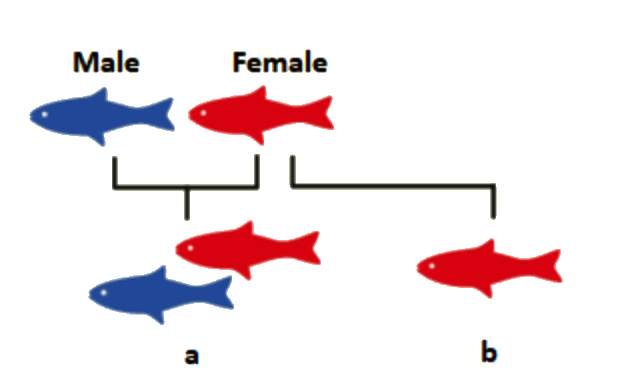Differentiate between :
(a) Xenogamy and Geitonogamy
(b) Oviparous and Viviparous organisms
(c) Parthenogenesis and Parthenocarpy
(a) Geitonogamy : This is transfer of pollen grains from anther to the stigma of another flower of the same plant.
(ii) It is genetically smilar to autogamy since pollengrains come from the same plant.
Xenogamy : (a) This is transfer of pollen grains from anther to the stigma of a different plant.
(iii) Here, genetically different pollen grains are brought to the stigma.
(b) Oviparous organisms : (i) Development of zygote takes place outside the body in the form of fertilised egg covered by a hard calcareous shell which after incubation brings forth the young ones.
(ii) Chances of survival of young one are less in oviparous organisms e.g : reptiles and birds.
Viviparous organisms : (i) Development of zygote takes place inside the body of a female organism and are delivered outside the body of the female orgamsin after reaching a certain stage of growth.
2. Chances of survival of young ones are more in viviparous organisms e.e : mammals.
Parthenogenesis The female gamete undergoes development to form new organisms without fertilization.
e.g : Rotifers and birds like (turkey).
Parthenocarpy : This is development of friut without the process of fertilization.
e.g : Banana.
Topper's Solved these Questions
- XII BOARDSBOOK - XII BOARD PREVIOUS YEAR PAPER ENGLISHCHAPTER - XII BOARDSEXERCISE - COMPTT
60 Videos
- XII BOARDSBOOK - XII BOARD PREVIOUS YEAR PAPER ENGLISHCHAPTER - XII BOARDSEXERCISE - SECTION-E
6 Videos
- XII BOARDSBOOK - XII BOARD PREVIOUS YEAR PAPER ENGLISHCHAPTER - XII BOARDSEXERCISE - OUTSIDE DELHI SET II
9 Videos
- SAMPLE PAPER 2019BOOK - XII BOARD PREVIOUS YEAR PAPER ENGLISHCHAPTER - SAMPLE PAPER 2019EXERCISE - Section E Part B
3 Videos
Similar Questions
Differentiate between parthenogenesis and parthenocarpy.
View SolutionDifferentiate between Oviparous and viviparous animals
View SolutionDifferentiate between
(a) Open circulatory system and closed circulatory system.
(b) Oviparous and viviparous characteristic.
(c ) Direct development and Indirect development.
View SolutionDifferentiate between
(a) Racemose and cymose inflorescence
(b) Fibrous roots and adventitious roots
(c) Apocarpous and syncarpous ovary
View SolutionDifferentiate between parthenocarpy and parthenogenesis giving example of each
View SolutionDifferentiate between the following:
(a) Dominance and Recessive
(b) Homozygous and Heterozygous
(c) Monohybrid and Dihybrid.
View SolutionDifferentiate between
a. quicklime b. limewater c. slaked lime
View SolutionDifferentiate between:
(a) Solidification and condensation
(b) Melting and boiling
(c) Gas and vapour
(d) Miscible and immiscible liquids
View SolutionObserve the diagram given below and identify a and b.

(1) a: Amphimixis , b : Parthenocarpy
(2) a: Amphimixis , b : Parthenogenesis
(3) a: Parthenocarpy ,b : Amphimixis
(4) a: Parthenogenesis , b: sexual reproduction
View Solution(a) Differentiate between three segments of a transistor on the basis of their size and level of doping.
(b) How is a transistor biased to be in active state?
(c) With the help of a necessary circuit diagram, describe briefly how n-p-n transistor in CE configuration amplifies a small sinusoidal input voltage. Write the expression for the ac current gain.
View Solution
